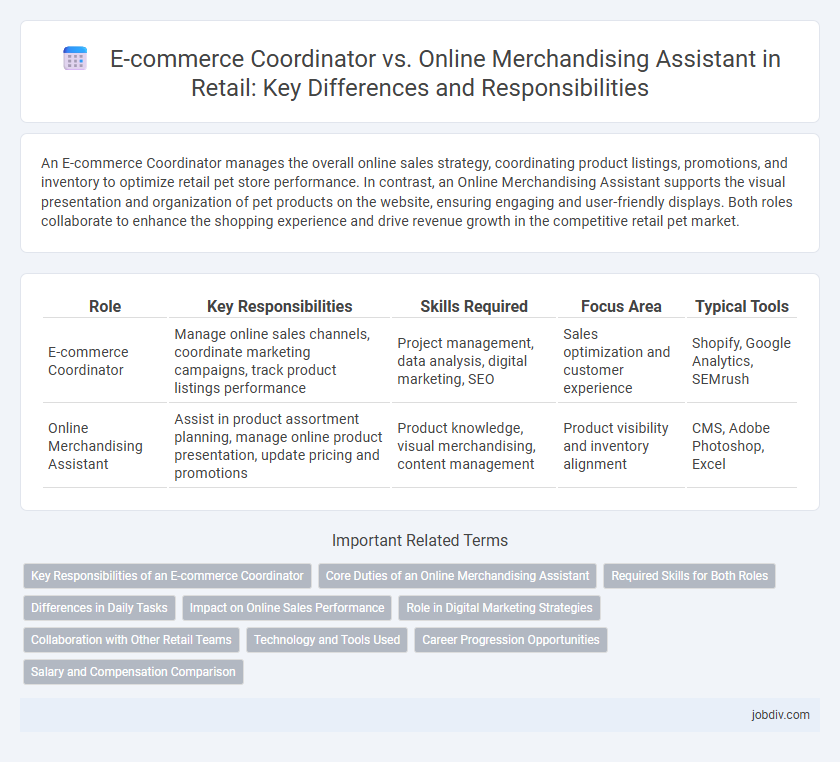An E-commerce Coordinator manages the overall online sales strategy, coordinating product listings, promotions, and inventory to optimize retail pet store performance. In contrast, an Online Merchandising Assistant supports the visual presentation and organization of pet products on the website, ensuring engaging and user-friendly displays. Both roles collaborate to enhance the shopping experience and drive revenue growth in the competitive retail pet market.
Table of Comparison
| Role | Key Responsibilities | Skills Required | Focus Area | Typical Tools |
|---|---|---|---|---|
| E-commerce Coordinator | Manage online sales channels, coordinate marketing campaigns, track product listings performance | Project management, data analysis, digital marketing, SEO | Sales optimization and customer experience | Shopify, Google Analytics, SEMrush |
| Online Merchandising Assistant | Assist in product assortment planning, manage online product presentation, update pricing and promotions | Product knowledge, visual merchandising, content management | Product visibility and inventory alignment | CMS, Adobe Photoshop, Excel |
Key Responsibilities of an E-commerce Coordinator
An E-commerce Coordinator manages online sales platforms by overseeing product listings, monitoring inventory levels, and coordinating marketing campaigns to drive traffic and increase conversions. They analyze sales data and customer behavior to optimize the user experience and implement promotional strategies that align with business goals. Collaboration with cross-functional teams ensures seamless order fulfillment and accurate digital merchandising across multiple channels.
Core Duties of an Online Merchandising Assistant
An Online Merchandising Assistant primarily manages product listings, updates inventory information, and ensures accurate pricing across e-commerce platforms to optimize customer experience and sales performance. They collaborate with marketing and buying teams to execute promotional campaigns and analyze user behavior data to improve product visibility and conversion rates. This role demands proficiency in content management systems, attention to detail, and an understanding of SEO principles to enhance online merchandising effectiveness.
Required Skills for Both Roles
E-commerce Coordinators require strong project management skills, proficiency in digital marketing tools, and data analysis capabilities to optimize online store performance. Online Merchandising Assistants need expertise in product assortment planning, visual merchandising, and familiarity with content management systems to enhance user experience. Both roles demand excellent communication, attention to detail, and a solid understanding of e-commerce platforms like Shopify or Magento.
Differences in Daily Tasks
E-commerce Coordinators primarily manage online store operations, including product listings, order processing, and coordinating between sales and marketing teams to enhance user experience. Online Merchandising Assistants focus on optimizing product displays, updating website visuals, and analyzing customer behavior to improve conversion rates. While both roles support e-commerce growth, Coordinators handle broader operational tasks, whereas Merchandising Assistants concentrate on visual presentation and sales data analysis.
Impact on Online Sales Performance
An E-commerce Coordinator directly influences online sales performance by managing product listings, coordinating marketing campaigns, and analyzing sales data to optimize conversion rates. An Online Merchandising Assistant supports these efforts by organizing product content, maintaining visual consistency, and implementing merchandising strategies that enhance user experience and drive customer engagement. Both roles are critical, but the E-commerce Coordinator typically has broader responsibility and greater impact on strategic sales outcomes.
Role in Digital Marketing Strategies
E-commerce Coordinators drive digital marketing strategies by managing online campaigns, optimizing product listings, and analyzing sales data to boost conversion rates. Online Merchandising Assistants support these efforts by curating product assortments, ensuring accurate online displays, and assisting with promotional content to enhance user experience and brand visibility. Both roles collaborate closely to improve customer engagement and maximize online revenue through targeted digital marketing initiatives.
Collaboration with Other Retail Teams
An E-commerce Coordinator typically works closely with marketing, sales, and IT teams to ensure seamless online store operations and promotional campaigns, facilitating synchronized product launches and inventory updates. In contrast, an Online Merchandising Assistant collaborates primarily with visual merchandising and content teams to optimize product presentation, enhance user experience, and drive online sales. Both roles rely on effective communication and cross-departmental teamwork to align e-commerce strategies with overall retail objectives.
Technology and Tools Used
E-commerce Coordinators primarily use advanced analytics platforms like Google Analytics and Adobe Commerce to optimize online sales performance, while Online Merchandising Assistants leverage content management systems (CMS) such as Shopify and Magento to manage product listings and digital storefronts. E-commerce Coordinators often employ automation tools like Zapier and CRM software including Salesforce to streamline customer interactions and inventory management. Online Merchandising Assistants focus on SEO tools, digital asset management (DAM) systems, and A/B testing software to enhance product visibility and user experience on e-commerce sites.
Career Progression Opportunities
E-commerce Coordinators often manage online sales strategies and coordinate cross-functional teams, positioning them for advancement into roles such as E-commerce Manager or Digital Marketing Specialist. Online Merchandising Assistants primarily focus on product presentation and inventory optimization, creating a foundation for growth into Merchandising Manager or Category Manager positions. Both roles provide essential experience in digital retail operations but differ in scope, affecting the trajectory and specialization of career development.
Salary and Compensation Comparison
An E-commerce Coordinator typically earns a higher salary, with averages ranging from $50,000 to $65,000 annually, reflecting responsibilities in project management and cross-departmental coordination. Online Merchandising Assistants usually receive compensation between $35,000 and $45,000, emphasizing product presentation and inventory management. Salary variations depend on factors like company size, location, and experience, with E-commerce Coordinators often benefiting from bonuses tied to sales performance.
E-commerce Coordinator vs Online Merchandising Assistant Infographic

 jobdiv.com
jobdiv.com